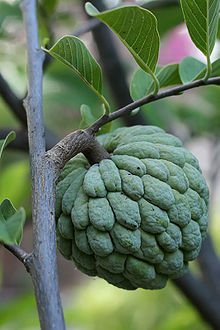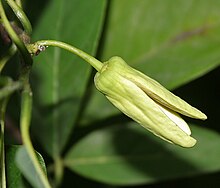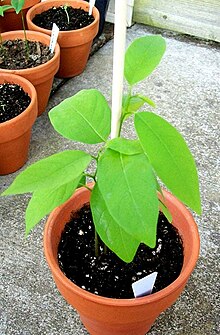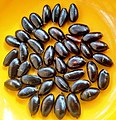Annona squamosa is a small, well-branched tree or shrub[7] from the family Annonaceae that bears edible fruits called sugar apples or sweetsops.[8] It tolerates a tropical lowland climate better than its relatives Annona reticulata and Annona cherimola[6] (whose fruits often share the same name)[3] helping make it the most widely cultivated of these species.[9]Annona squamosa is a small, semi-(or late) deciduous,[10]much-branched shrub or small tree 3 to 8 metres (10 to 26 feet) tall[7][10]similar to soursop (Annona muricata).[11] It is a native of tropical climate in the Americas and West Indies, and Spanish traders aboard the Manila galleons docking in the Philippines brought it to Asia.[12]
| Annona squamosa | |
|---|---|
 | |
 | |
| Cross section of the fruit shown on right | |
| Scientific classification | |
| Kingdom: | Plantae |
| Clade: | Tracheophytes |
| Clade: | Angiosperms |
| Clade: | Magnoliids |
| Order: | Magnoliales |
| Family: | Annonaceae |
| Genus: | Annona |
| Species: | A. squamosa |
| Binomial name | |
| Annona squamosa | |
| Synonyms | |
Annona asiatica L.[3] | |

The fruit is spherical-conical, 5–10 centimetres (2–4 inches) in diameter and 6–10 cm (2+1⁄4–4 in) long, and weighing 100–240 grams (3.5–8.5 ounces), with a thick rind composed of knobby segments. The colour is typically pale green through blue-green, with a deep pink blush in certain varieties, and typically has a bloom. It is unique among Annona fruits in being segmented; the segments tend to separate when ripe, exposing the innards.
The flesh is fragrant and sweet, creamy white through light yellow, and resembles and tastes like custard. The seeds are coated with the flesh, It is found adhering to 13-to-16-millimetre-long (1⁄2 to 5⁄8 in) seeds forming individual segments arranged in a single layer around a conical core. It is soft, slightly grainy, and slippery. The hard, shiny seeds may number 20–40 or more per fruit and have a brown to black coat, although varieties exist that are almost seedless.[12][13] The seeds can be ground for use as an insecticide.[8]The stems run through the centre of the fruit connecting it to the outside. The skin is shaped like a Reuleaux triangle coloured green and rough in texture. Due to the soft flesh and structure of the sugar apple it is very fragile to pressure when ripe.
New varieties are also being developed in Taiwan and Hong Kong. The atemoya or "pineapple sugar-apple", a hybrid between the sugar-apple and the cherimoya, is popular in Taiwan, although it was first developed in the United States in 1908. The fruit is similar in sweetness to the sugar-apple, but has a very different taste. As its name suggests, it tastes like pineapple.
Description



The fruit of A. squamosa (sugar-apple) has sweet whitish pulp, and is popular in tropical markets.[10]
Stems and leaves

Branches with light brown bark and visible leaf scars; inner bark light yellow and slightly bitter; twigs become brown with light brown dots (lenticels – small, oval, rounded spots upon the stem or branch of a plant, from which the underlying tissues may protrude or roots may issue).[6]
Thin, simple, alternate leaves[11] occur singly,[6] 5 to 17 centimetres (2 to 6+3⁄4 inches) long and 2 to 6 cm (3⁄4 to 2+3⁄8 in) wide;[10][6] rounded at the base and pointed at the tip (oblong-lanceolate).[10] They are pale green on both surfaces and mostly hairless[6] with slight hairs on the underside when young.[7] The sides sometimes are slightly unequal and the leaf edges are without teeth, inconspicuously hairy when young.[6][11]
The leaf stalks are 0.4 to 2.2 cm (1⁄8 to 7⁄8 in) long,[10] green, and sparsely pubescent.[6]
Flowers
Solitary or in short lateral clusters of 2–4 about 2.5 cm (1 in) long,[10] greenish-yellow flowers on a hairy, slender[6] 2 cm (3⁄4 in) long stalk.[10] Three green outer petals, purplish at the base, oblong, 1.6 to 2.5 cm (5⁄8 to 1 in) long, and 0.6 to 0.75 cm (1⁄4 to 5⁄16 in) wide, three inner petals reduced to minute scales or absent.[7][10] Very numerous stamens; crowded, white, less than 1.6 cm (5⁄8 in) long; ovary light green. Styles white, crowded on the raised axis. Each pistil forms a separate tubercle (small rounded wartlike protuberance), mostly 1.3 to 1.9 cm (1⁄2 to 3⁄4 in) long and 0.6 to 1.3 cm (1⁄4 to 1⁄2 in) wide which matures into the aggregate fruit.[6]
Flowering occurs in spring-early summer[10] and flowers are pollinated by nitidulid beetles.[14] Its pollen is shed as permanent tetrads.[15]
Fruits and reproduction
Fruits ripen 3 to 4 months after flowering.[16]
Aggregate and soft fruits form from the numerous and loosely united pistils of a flower[6] which become enlarged[10] and mature into fruits which are distinct from fruits of other species of genus[6] (and more like a giant raspberry instead).
The round or heart-shaped[6] greenish yellow, ripened aggregate fruit is pendulous[10] on a thickened stalk; 5 to 10 cm (2 to 3+7⁄8 in)[6][7] in diameter[10][11] with many round protuberances[6] and covered with a powdery bloom. Fruits are formed of loosely cohering or almost free carpels (the ripened pistels).[7]
The pulp is white tinged yellow,[7] edible and sweetly aromatic. Each carpel containing an oblong, shiny and smooth,[6] dark brown[7] to black, 1.3 to 1.6 cm (1⁄2 to 5⁄8 in) long seed.[6]
Nutrition and uses
| Nutritional value per 100 g (3.5 oz) | |
|---|---|
| Energy | 393 kJ (94 kcal) |
23.64 g | |
| Dietary fiber | 4.4 g |
0.29 g | |
2.06 g | |
| Vitamins | Quantity %DV† |
| Thiamine (B1) | 9% 0.11 mg |
| Riboflavin (B2) | 9% 0.113 mg |
| Niacin (B3) | 6% 0.883 mg |
| Pantothenic acid (B5) | 5% 0.226 mg |
| Vitamin B6 | 12% 0.2 mg |
| Folate (B9) | 4% 14 μg |
| Vitamin C | 40% 36.3 mg |
| Minerals | Quantity %DV† |
| Calcium | 2% 24 mg |
| Iron | 3% 0.6 mg |
| Magnesium | 5% 21 mg |
| Manganese | 18% 0.42 mg |
| Phosphorus | 3% 32 mg |
| Potassium | 8% 247 mg |
| Sodium | 0% 9 mg |
| Zinc | 1% 0.1 mg |
| †Percentages estimated using US recommendations for adults,[17] except for potassium, which is estimated based on expert recommendation from the National Academies.[18] | |
Sugar-apple is high in energy, an excellent source of vitamin C and manganese, a good source of thiamine and vitamin B6, and provides vitamin B2, B3 B5, B9, iron, magnesium, phosphorus and potassium in fair quantities.[19]
Chemistry
The diterpenoid alkaloid atisine is the most abundant alkaloid in the root. Other constituents of Annona squamosa include the alkaloids oxophoebine,[20] reticuline,[20] isocorydine,[21] and methylcorydaldine,[21] and the flavonoid quercetin-3-O-glucoside.[22]
Bayer AG has patented the extraction process and molecular identity of the annonaceous acetogenin annonin, as well as its use as a biopesticide.[23] Other acetogenins have been isolated from the seeds,[24] bark,[25] and leaves.[citation needed]
Distribution and habitat
Annona squamosa is native to the tropical Americas and West Indies, but the exact origin is unknown. It is now the most widely cultivated of all the species of Annona, being grown for its fruit throughout the tropics and warmer subtropics, such as Indonesia, Thailand, Taiwan, and China as far north as Suzhou;[26] it was introduced to southern Asia before 1590. It is naturalized as far north as southern Florida in the United States and as south as Bahia in Brazil, Bangladesh, and is an invasive species in some areas.[6][9][11]
- Native
- Neotropic
- Caribbean: Antigua and Barbuda, Bahamas, Barbados, Cuba, Dominica, Dominican Republic, Grenada, Guadeloupe, Haiti, Jamaica, Martinique, Montserrat, Netherlands Antilles, Puerto Rico, St Kitts and Nevis, St Lucia, St Vincent and the Grenadines, Suriname, Trinidad and Tobago, Virgin Islands.
- Central America: Costa Rica, El Salvador, Guatemala, Honduras, Nicaragua, Panama
- Northern South America: Suriname, French Guiana, Guyana, Venezuela
- Western South America: Bolivia, Colombia, Ecuador, Peru
- Southern South America: Argentina, Brazil, Chile, Paraguay, Uruguay[6]
- Naturalised
- Pacific: Samoa, Tonga
- North America: Mexico, Belize
- Afrotropic: Angola, Namibia, Sudan, Tanzania, Uganda, Zanzibar, Kenya
- Australasia: Australia, Fiji, New Zealand, Papua New Guinea, Solomon Islands
- Indomalaya: Bangladesh, Cambodia, China, India, Indonesia, Laos, Malaysia, Nepal, Pakistan, Philippines, Sri Lanka, Taiwan, Thailand, Vietnam
- Palearctic: Cyprus, Greece, Lebanon, Malta,[6] Israel
Climate and cultivation
Like most species of Annona, it requires a tropical or subtropical climate with summer temperatures from 25 °C (77 °F) to 41 °C (106 °F), and mean winter temperatures above 15 °C (59 °F). It is sensitive to cold and frost, being defoliated below 10 °C (50 °F) and killed by temperatures of a couple of degrees below freezing. It is only moderately drought-tolerant, requiring at least 700 millimetres (28 in) of annual rainfall, and does not produce fruit well during droughts.
It will grow from sea level to an altitude of 2,000 metres (6,600 feet) and thrives in hot dry climates, differing in its tolerance of lowland tropics from many of the other fruit bearers in the Annona family.
It is quite a prolific bearer, and it produces fruit within as little as two to three years. A five-year-old tree can produce as many as 50 sugar apples. Poor fruit production has been reported in Florida because there are few natural pollinators (honeybees have a difficult time penetrating the tightly closed female flowers); however, hand pollination with a natural fibre brush is effective in increasing yield. Natural pollinators include beetles (coleoptera) of the families Nitidulidae, Staphylinidae, Chrysomelidae, Curculionidae and Scarabaeidae.[9][13]
Ecology
In the Philippines, the fruit is commonly eaten by the Philippine fruit bat (kabag or kabog), which then spreads the seeds from island to island.
It is a host plant for larvae of the butterfly Graphium agamemnon (tailed jay).
Uses
In traditional Indian, Thai, and Native American medicines, the leaves are boiled down with water, possibly mixed with other specific botanicals, and used in a decoction to treat dysentery and urinary tract infection.[27] In traditional Indian medicine, the leaves are also crushed for use as a poultice, and applied to wounds.[27] In Mexico, the leaves are rubbed on floors and put in hens' nests, to repel lice.[9]In Haiti, the fruit is known as cachiman and is used to simply make juice.[28]In Lebanon and Syria, it is made into a variety of desserts and sweets, referred to as ashta.[citation needed]
Gallery
- Annona squamosa fruit from Myanmar
- Sugar apple (right), with Taiwanese "pineapple shijia" (atemoya) (left)
- The sugar apple readily breaks open when ripe.
- A deconstruction of a sugar apple shows a lobe of fruit and pulpy segments with seeds.
- A sugar apple ready to eat
- Sugar apple (Annona squamosa) seeds
- Red sugar apples from Myanmar
- Sugar apples in Taitung, Taiwan
- Sugar apple tree in Philippines
- Two sugar apples in Bangladesh
- A sugar apple in tree in Terai of Nepal
References
External links

 Data related to Annona squamosa at Wikispecies
Data related to Annona squamosa at Wikispecies
- "Annona squamosa L." Integrated Taxonomic Information System. Retrieved 17 March 2008.
- David Lee. "Photographs of trees Annona squamosa". The Miami Tree Puzzle. Florida International University. Archived from the original on 7 April 2008. Retrieved 2008-04-17.
- Annona squamosa L. Medicinal Plant Images Database (School of Chinese Medicine, Hong Kong Baptist University) (in Chinese) (in English)













